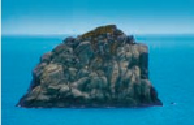Travel Reference
In-Depth Information
The Īfu-bīchi hoteru is one of the most popular choices on Kume Island. Located right on the beach,
you can step out of your room and you're there.
Eef Beach, one of nicest beaches in Japan or anywhere, is more than three-quarters of a mile (1 kilometer)
of pure white sand. It has a gentle grade and fronts on crystal-clear, warm waters.
Tonbara Rock, a remarkable solitary, upright stone “monument” well offshore of Cape Shimajiri or “Bot-
tom of the Island Cape,” at the southeastern-most tip of Kume Island.
If you're lucky you might even chance upon sea turtles as they lay and bury their eggs.
We purposefully haven't yet mentioned the tatami-stone beach on Ōjima (page
187
) or the
3.75-mile (6-kilometer)-long Hatenohama sand island beach (page
188
) because we'll cover
them individually further below as they're located on separate islands.
Although we've explored most of Kume's best-known sights, there is still one more very
fine excursion and it's not far. Due south 3 miles (5 kilometers) from Eef Beach, you'll come
to the bottom of the island and the end of the road. The route follows the eastern coastline of
what is essentially a great peninsula, the largest on Kume. It's so wild that there are no roads
whatsoever on the entire western side of it. With the exception of a few cattle farms, almost
all the peninsula has been declared a natural reserve.
The island ends at Cape Shimajiri (
島尻崎
; Shima-jiri-zaki; lit. “Bottom of the Island
Cape”), and here begin the possibilities for several hikes up some pretty steep hillsides. At
one point you'll come to the Bird's Beak Rock (
鳥の口
; Tori-no kuchi). It's sort of an upright


